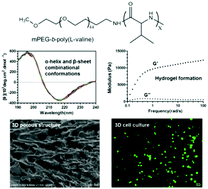Self-assembled PEG–poly(l-valine) hydrogels as promising 3D cell culture scaffolds†
Abstract
Self-assembled polypeptide aggregates have shown great promise in biomedical fields including drug delivery, tissue regeneration and regenerative medicine. In this study, we report self-assembled hydrogels based on mPEG-block-poly(L-valine) (PEV) copolymers. PEV copolymers with varying poly(L-valine) chain lengths were prepared by the ring-opening polymerization of N-carboxy anhydrides of L-valine using mPEG-NH2 as the initiator. 1H NMR and GPC confirmed their well-defined chemical structures. FT-IR analysis and DSC curves indicated the combined α-helix and β-sheet secondary polypeptide conformation and the PEG crystallization microphase in bulk solid state, respectively. Moreover, the poly(L-valine) block restricted the crystallization of PEG segment. DLS, TEM and circular dichroism spectra were employed to study the self-assembly profiles of PEV copolymers in aqueous solution. The results manifested that in diluted solution, PEV copolymers showed a combination of typical β-sheet and α-helical polypeptide structures and self-assembled into nanostructures with diverse morphologies and sizes. For concentrated PEV solutions, clear hydrogel phases were observed and dynamic rheological analyses demonstrated that the hydrogel modulus was sensitive to the polypeptide length, angular frequency, shear strain and temperature. The hydrogel formation was possibly dominated by the physical aggregation of PEV nanoassemblies as well as driven by the formation of particular polypeptide secondary structures. Human fibroblast NIH/3T3 cells were encapsulated and cultured within the hydrogel scaffolds. The encapsulated cells exhibited high viability, suggesting that PEV hydrogels have excellent cytocompatibility and could be used as three-dimensional (3D) cell culture matrices. Collectively, self-assembled PEGylated poly(L-valine) conjugate hydrogels represented a new kind of biomaterial scaffold in biomedical fields including but not limited to 3D cell culture.



 Please wait while we load your content...
Please wait while we load your content...